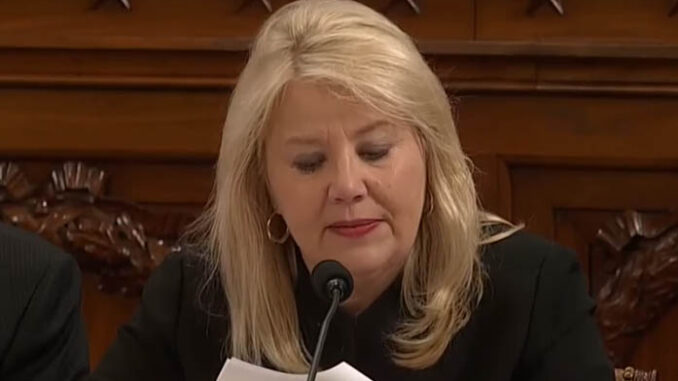
by Staff Reporter | Dec 8, 2024 | News
By Staff Reporter |
A recent decision by the Environmental Protection Agency (EPA) concerning Maricopa County may have been politically motivated and may pose a national security risk.
The EPA decided earlier this week to reclassify Maricopa County to “serious” nonattainment status for its ozone National Ambient Air Quality Standards (NAAQS). Congresswoman Debbie Lesko claimed that the EPA’s reclassification poses a national security risk in a Wednesday press release. The congresswoman argued that finalization of the reclassification ahead of a second Trump administration would jeopardize Arizona’s newly established semiconductor manufacturing.
“If the EPA continues its expedited schedule in a rush to make their reclassification effective before the Trump Administration takes office, it will negatively impact Arizona and national security,” said Lesko. “The Taiwan Semiconductor Manufacturing Company (TSMC) was just awarded $6.6 Billion in CHIPS Act funding. This action by the EPA could jeopardize that funding and makes absolutely no sense.”
Lesko speculated in letters of appeal to the EPA and Commerce Department that the EPA was acting in a rushed response to undermine president-elect Donald Trump’s incoming administration.
“The reason for this [EPA] change is not clear to me, but I am concerned that this action was taken based upon the political reality of the upcoming administration change,” said Lesko.
Lesko further argued the EPA was “premature” in its reclassification. Lesko referenced an understanding via communications with the EPA that the agency wouldn’t issue its decision until next May.
Not only has the EPA acted prematurely, Lesko argued, but their expedited timeline works outside of the legal requirement to have a 180-day window for redesignation from Aug. 3, 2024, which would land on Jan. 30, 2025. The presidential inauguration takes place on Jan. 20, 2025. Lesko asked the EPA to honor its original May timeline.
EPA Region 9 advised Maricopa County Air Quality that they would issue a Federal Register Notice containing an “expedited redesignation” within the coming weeks.
The redesignation would lower Maricopa County’s emissions threshold from 100 tons to 50 tons for major sources of nitrogen oxides and volatile organic compounds. Lesko said these adjustments would jeopardize TSMC operations.
“TMSC’s new plant requires an air quality permit to proceed. The current major source threshold of 100 tons would allow TSMC to proceed without needing to acquire emission reduction credits (ERCs),” said Lesko. “However, a redesignation to serious nonattainment would impose the 50-ton threshold, which is currently unfeasible due to the shortage of available ERCs, thus potentially delaying or halting this key project.”
Lesko cited further concerns that the expedited redesignation would harm the Maricopa County and Arizona economies by dissuading industry growth and recruitment for technology and advanced manufacturing.
Maricopa County Air Quality issued a release earlier this year warning that the EPA would reclassify their ozone nonattainment from “moderate” to “serious” nonattainment prior to Feb. 3, 2025.
The EPA included Maricopa County in its final rule, finding it in October as an area that failed to submit a plan addressing EPA ozone requirements for moderate nonattainment areas. The EPA reclassified Maricopa County from marginal to moderate in 2022, and gave the county until last January to submit its plan.
AZ Free News is your #1 source for Arizona news and politics. You can send us news tips using this link.

by Staff Reporter | Dec 7, 2024 | News
By Staff Reporter |
Arizona’s unified organization of general contractors are in opposition to a lawsuit by local Republican Party leaders over the voter-approved sales tax that, ultimately, benefits them.
The Arizona Chapter of the Associated General Contractors of America (AZAGC) said in a press release that the latest lawsuit from the Maricopa County Republican Committee (MCRC) challenging the passage of Proposition 479 was a “frivolous” action undertaken by “disgruntled partisans.”
Prop 479 continued an existing .05 cent sales tax, revenues which fund Maricopa County’s infrastructure and, naturally, the general contractors that build it. MCRC filed suit on Monday in the Maricopa County Superior Court.
MCRC argued against the claim that Prop 479 amounts to a mere continuation of the state’s decades-old sales tax. In their lawsuit, MCRC argued that the proposition instills a new tax for new projects. What’s more, the committee argued that the proposition didn’t pass the 60 percent voter threshold needed for a new tax.
The measure gained 59.82 percent of the vote (out of two million voters); the measure was approved with 80 percent turnout.
Voters first established the half-cent tax in 1985 and last renewed it in 2004. The tax extends through 2045 under the proposition, which established a 20-year continuation. Maricopa County Association of Governments (MAG) estimated generated revenues to amount to $15 billion under 2020 dollars.
40 percent of the sales tax revenues go to freeways and highways, 22 percent go to arterial roads and regional transportation infrastructure, and 37 percent go to transit.
MAG further estimated that funds generated under the tax would allow for infrastructure that would keep the average commute length at 30 minutes through 2050, even after adding 1.7 million residents and 900,000 jobs.
Prop 479’s investment plan concerns reducing the average afternoon commute by one-third and reducing congestion by 51,000 hours on critical freight corridors daily. It also concerns increasing the number of amenities within a 30-minute drive by 12 percent, creating $2.4 billion in net new economic activity per year, saving local businesses $1.6 billion per year in travel time savings, and creating and supporting 31,600 jobs annually.
AZAGC President David Martin predicted the courts would dismiss the lawsuit before it gained any ground, but not soon enough to mitigate the damages of unnecessary costs to taxpayers. Martin avoided mention of the fiscal opportunities that contractors stand to make with the success of Prop 479.
“It’s clear this frivolous lawsuit has no merit and will eventually be thrown out by the courts” said Martin. “It’s hypocritical that these ‘conservatives’ insist on having tax dollars wasted defending a lawsuit that clearly will not stand up in the courts.
AZAGC claimed in its press release that the .05 cent sales tax is necessary because all benefit from county infrastructure, including MCRC members.
“The roads in Maricopa County are funded by the ½ cent sales tax as well as other taxes. Members of the MCRC use these roads to get to and from work, take their kids to school and go to the grocery store,” said the press release. “Instead of paying their fair share for public streets, members of the MCRC would rather have drivers stuck in traffic away from their families and pay exorbitant maintenance costs for damage caused by potholes.”
Among those siding with AZAGC were top Democratic leaders like Phoenix Mayor Kate Gallego. The mayor also issued a statement on the matter, adopting similar language to AZAGC in denouncing the MCRC lawsuit as “malignant,” “deeply flawed,” and “misguided.”
“Maricopa County voters overwhelmingly passed Prop 479 because they understand that a strong transportation system isn’t political—it’s critical to our future,” said Gallego.
AZ Free News is your #1 source for Arizona news and politics. You can send us news tips using this link.

by Staff Reporter | Dec 7, 2024 | Education, News
By Staff Reporter |
Arizona grew the number of Education Savings Plan (or “AZ529”) accounts to nearly 47,600 over the last four years.
Arizona Treasurer Kimberly Yee reported that assets of those accounts increased nearly 50 percent to $2.4 billion within the last four years.
AZ529 accounts allow parents, grandparents, or future students to take a tax-advantaged approach to saving for their educational expenses. Those opening the accounts also don’t need to be related to the beneficiary, and they may accept gifts to these accounts from others.
The opening cost for an AZ529 account starts with investments as low as $15 monthly and no application fee, with plan providers going up to $25 and $150.
AZ529 savings may be used at most accredited public or private universities, colleges, community colleges, technical and vocational schools nationwide, or apprenticeship programs, and even certain foreign institutions.
Qualified educational expenses include tuition and fees; books, supplies, and equipment; public, private, or religious K-12 school tuition for up to $10,000 per year; and up to $10,000 in student loan repayments.
Under these accounts, distributions are exempt from Arizona income tax and federal income tax. AZ529 received Morningstar’s 2023 Silver Rating.
Not only are the distributions tax-exempt, but contributions are tax deductible. Arizona allows AZ529 contributors to receive deductions of up to $4,000 per beneficiary for married tax filers who file a joint return and $2,000 per beneficiary for individual tax filers.
AZ529 plans must be funded by December 31 of this year to be eligible for deductions on 2024 taxes.
Arizona offers two financial institutions for AZ529 plans: Fidelity Investments and Goldman Sachs 529 Plan. The former allows for personal account opening, while the latter allows for personal or financial advisors to open accounts. Both have contribution limits of $590,000.
AZ529 also offers an annual essay writing contest, with hundreds of dollars in rewards offered. This past year, 20 students won over $500 toward their AZ529 accounts out of the over 600 who participated.
This year, the state began allowing certain “leftover” AZ529 funds to be transferred to a Roth IRA free of any tax, penalty, or applicable income limits for the first time. Qualifying AZ529 accounts have been maintained for a minimum of 15 years under the same owner and same designated beneficiary, and the amount transferred must also have been contributed at least five years prior to the transfer and the aggregate lifetime limit for rolling over is $35,000.
Or, account owners have the option to change the name of the beneficiary to another. In the event that the beneficiary receives a scholarship, becomes disabled, or dies, the account owner may withdraw the assets in the account without incurring the 10 percent federal tax penalty normally issued for non-qualified withdrawals.
Congress created 529 plans in 1996, officially known as “qualified tuition programs.” AZ529 plans are the state of Arizona’s version of these programs.
Federal financial aid programs may take up to about six percent of the AZ529 account balance into consideration as a parental asset when determining eligibility for need-based aid.
AZ Free News is your #1 source for Arizona news and politics. You can send us news tips using this link.

by Staff Reporter | Dec 5, 2024 | Education, News
By Staff Reporter |
The Arizona Department of Health Services (AZDHS) called for the removal of guns from all homes with children.
AZDHS made the recommendation for family homes to have their firearms removed in their latest Arizona Child Fatality Review Program (CFRP) report, released last month. This annual report is submitted to the governor and leaders of both the House and Senate for the purpose of guiding policy and even influencing state intervention.
“CFRP believes that the most effective way to prevent firearm-related deaths in children is to remove all firearms in households with children because the presence of firearms in a household increases the risk of suicide among adolescents,” stated the opening letter of the report. “Parents of all adolescents should remove all guns from their homes, especially if there is a history of mental health issues or substance use issues. In addition, CFRP recommends that all gun owners should practice safe storage of their firearms by keeping guns unloaded and locked in a safe separate from the ammunition.”
The report recommended that the state should require mental health screening and gun safety training as prerequisites to purchasing firearms, license and track all firearms, and punish people for failing to report stolen firearms.
The report also recommended that policy makers, participating agencies, and schools launch public awareness campaigns advising the removal of all firearms from their households.
According to that report, nearly 70 minors died from preventable firearm injuries last year. Of those deaths, 44 percent (30 deaths) were suicides. 75 percent occurred in children ages 15-17 years, and 84 percent of firearm injury deaths were among males.
The leading risk factors of firearm injury deaths were: access to firearms (60 percent), CPS history with the family (59 percent), substance use (56 percent), history of violence or trauma (46 percent), and an unlocked firearm (40 percent).
Firearms were not the leading cause of preventable deaths for Arizona minors.
The top leading cause of preventable deaths among minors occurred from motor vehicle crashes (81 deaths, 20 percent), followed by firearm injury (68 deaths, 16 percent), then suffocation (52 deaths, 13 percent), poisoning (34 deaths, eight percent), and drowning (31 deaths, seven percent).
Founding member and chairwoman Mary Rimsza authored the opening letter which recommended the total removal of guns from homes with children, and the unloading and locking up of guns in all other homes.
Rimsza is a pediatrician, fellow of the American Academy of Pediatrics, professor of pediatrics at Mayo Graduate School of Medicine, and research professor of Health Management and Policy at Arizona State University.
Rimsza advocated for mandatory masking and vaccinations throughout the COVID-19 pandemic in the media while serving as the advocacy committee chair for the Arizona chapter of the American Academy of Pediatrics.
According to her X profile, Rimsza has also advocated for eating less meat and indicated her support for Democrats across the board, expressing avid support for Joe Biden’s presidential candidacy and opposition to the reelection of Donald Trump in 2020.
In a separate X profile, Rimsza shared a statement from the American Academy of Pediatrics claiming that racism impacts the physical health of children.
AZ Free News is your #1 source for Arizona news and politics. You can send us news tips using this link.

by Staff Reporter | Dec 4, 2024 | Education, News
By Staff Reporter |
Two Utah residents have been indicted for defrauding Arizona’s school choice program.
The alleged culprits, Johnny Lee Bowers and Ashley Meredith Hewitt (aka “Ashley Hopkins”), were indicted for the theft of about $110,000 from December 2022 through this May, Attorney General Mayes announced on Monday.
Bowers and Hewitt allegedly used the Empowerment Scholarship Account (ESA) program funds for their personal living expenses in Colorado. The pair are now believed to be living in Utah, per Mayes’ office.
Bowers and Hewitt allegedly submitted applications to the Arizona Department of Education (ADE) for seven real and 43 fictitious children using false, forged, or fraudulent documents such as birth certificates, utility bills, and lease agreements. Bowers and Hewitt applied under their own names as well as under fake identities, called “ghost parents.”
The pair put the false identities under fictitious “families” with the surnames Gil, Cole, Diaz, and Dobbs, as well as another “family” going by Hewitt’s surname.
Bowers and Hewitt were indicted on counts of the class two felonies of conspiracy (one count) and fraudulent schemes and artifices $100,000 or more (one count), as well as the class four felony of forgery (58 counts).
In a statement on the indictments, Arizona Superintendent Tom Horne said that the fraud was found out thanks to the auditor he hired to oversee the ESA Program, a position he noted was not previously established under his predecessor, Kathy Hoffman. Horne clarified that it was his office who referred the findings of fraud to Mayes’ team.
“As a former Arizona Attorney General, I am determined as Superintendent to eliminate any fraud within the ESA program. Upon taking office, I hired an auditor who had been in the Auditor General’s office for 15 years, and who is now in charge of the ESA program as well as an investigator. Those two positions had not existed under my predecessor,” said Horne. “I am pleased that prosecutions are following in the cases we sent to The Attorney General’s office.”
Earlier this year, five others were indicted in a similar $600,000 “ghost children” scheme to defraud the ESA program. 17 children were used in those applications — five of whom were discovered to be fake — associated with false birth certificates and false disability documents to obtain more funding. Those indicted were Dolores Sweet, Dorrian Jones, Jennifer Lopez, Jadakah Johnson, and Raymond Johnson, Jr.
Sweet allegedly approved applications for three fictitious children she claimed as her own while working as an ESA account specialist from 2019 to 2023. Both Johnsons are Sweet’s real adult children.
Lopez allegedly approved applications for two fictitious children she also claimed as her own while working as an ESA program lead specialist from 2019 to 2023.
Jones worked with the ADE as an administrative services officer.
As with these most recent indictments, the five indicted earlier this year were hired by Horne’s predecessor and later caught by Horne’s auditor.
In an October meeting, Horne announced that ESA reimbursements have proved to be “an overwhelming problem” for ADE due to low staffing, resulting in long wait times and a growing backlog.
Prior to last year, the ESA program paid through ClassWallet. The legislature approved tuition payments through reimbursement last year, something Horne says is the root of the problem.
Horne explained that efforts to combat the backlog have allowed for fraud to enter, citing an attempt to streamline reimbursements earlier this year by automatically reimbursing purchases at $75 or less leading to an instance of seven account holders discovered to have bought $13,000 of Amazon gift cards.
The ESA program has over 83,000 students enrolled as of mid-November.
AZ Free News is your #1 source for Arizona news and politics. You can send us news tips using this link.





